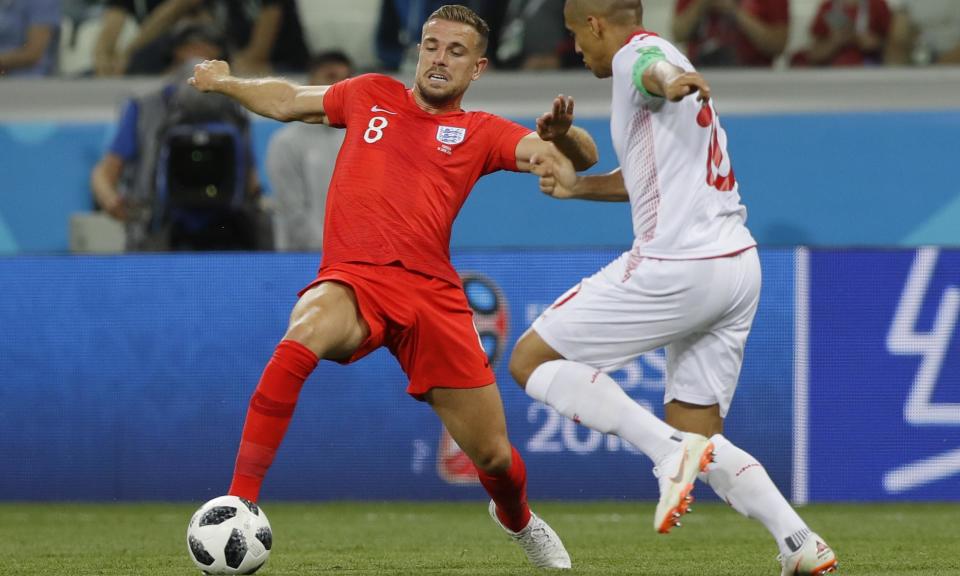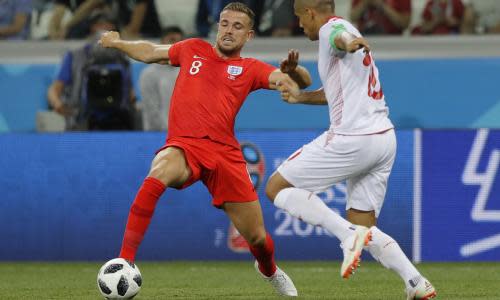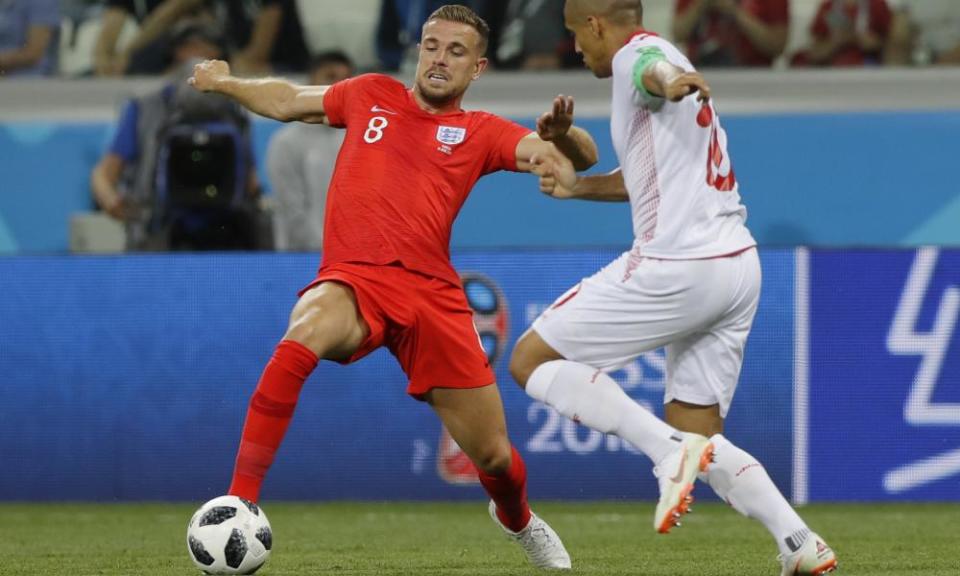Jordan Henderson’s adaptability makes him more than just a handyman
There was a moment of double-take midway through the second half at the Volgograd Arena on Monday, as England’s players fretted and fumbled, falling into the old stodgy patterns, that feeling of playing football though a warm summer fog.
At which point a vast Mexican wave broke out around the stadium. Seconds later there was a starburst of lighted mobile phones followed by gleeful chants of “Ross-iy-ya, Ross-iy-ya” from locals immune to the slow agony of watching England’s moment starting to pass in front of your nose, the Reasonably Hopeful Age of Gareth starting to flap and fray like a sweat-soaked blue nylon FA waistcoat gnawed apart at the seams by a thousand marshland mosquitoes.
Through all this one England player seemed to be moving to a different rhythm. From high up in the stands there was something jarring about the patterns carved out by Jordan Henderson’s No 8 shirt as it broke ranks, bustled into other players’ spaces and ran a few dead-ends. As Henderson popped up on the right and punted a deep cross out of play there were groans, a muscle memory of the familiar old high-speed imprecision.
Henderson is unlikely to get much credit for the manner of England’s 2-1 victory. The key quality, universally identified, was the way England kept calm, became less, not more, frantic as the last knockings played out.
Whereas in the depths of that second half Henderson had played like the antitheses of this. No doubt some will see an image of the classic English chief midfield-donkey, a flushed and barking ghost of tournament failures past. Henderson is still seen in these circles as a low-grade hustler, a sub-thoroughbred who has so often been present, the hotdog seller in the background of history, when England have experienced one of their recent moments of epic disarray.
This was different. England needed a little anger on Monday. This was a tactical response to a shift within the game rather than running for running’s sake.
In England’s best period early on Henderson had played a different way, striding around in more stately fashion as a free presence behind the attacking four and able to thread some precise forward passes.
After half-time, Tunisia shifted their own midfield, getting close to him and stretching that supply line thin. It was a smart disruptive move. The 3-1-2-2-1-1 shape demands that the lone central pivot provides a complete midfield janitorial service, working constantly with the balance and rhythm of the game to keep all the cogs and wheels whizzing round.
Henderson suits the role. He acts as a kind of hyperactive guilty conscience in any team. In Volgograd, he had more touches and made more passes than any other midfielder. But he also managed elements that go beyond the bare numbers.
At one point in the second half he even he seemed to start a pointless fight with Tunisia’s players at a free-kick. Boorish stuff perhaps, but England did need to disrupt Tunisia in return, to throw a couple of kidney punches. Nobody else in this team of mannered technicians was likely to shift the emotional gears.
Despite his reputation as a scuffler Henderson has always been an adaptive footballer. Appearances can be deceptive, just as the reputation for fixed roles and closed thinking among English footballers is notoriously overstated. You want growth and evolution? England’s midfield conduit started as a right-winger at Sunderland. In the past year, Jürgen Klopp has worked hard at fashioning him into a midfielder who runs both ways in the central European style.
READ MORE: Fekir denies knee problem ended transfer plans with Liverpool
READ MORE: The best and worst of VAR at the World Cup
READ MORE: Vinicius Junior snubbed Neymar and Barcelona to partner Ronaldo
It is no secret there will be objections to any satisfaction with England’s winning start. Lads: it’s Tunisia. Lads, it’s Tunisia without their best player, who got here by finishing one point ahead of DR Congo in qualifying.
But Tunisia were good enough to spook England a little, to raise the 2016 ghosts of Saint-Étienne in the second half, when the only response to Slovakia’s resistance was pained, static possession. If England really are keen to bury the ghosts of the recent past then their midfield handyman is key to this.
Nobody else in the team is so closely marked by those traumas. Before Monday, Henderson’s tournament record read: played five, won zero. He was there for Italy in Kiev in 2012, the day Andre Pirlo looked like the only grown-up on the pitch. He was there for the defeat by Uruguay in São Paulo in 2014. He was there on the bench for the brain-freeze against Iceland in Nice in 2016. He carries the gene.
With this in mind, Sunday in Nizhny Novgorov will come around quite quickly now. Gareth Southgate is too clear-sighted not to think about changing the balance of his team after an imperfect performance. England lacked width on the left. Danny Rose might be a better option against Panama’s deep defence.
Raheem Sterling should stay in the team, although Dele Alli’s likely absence with injury takes away the possibility England might finally play their best midfield finisher close to Harry Kane.
If Alli does miss out the likely presence of Ruben Loftus-Cheek could be good for Henderson too. What England lack is passing craft. Loftus-Cheek could add this, a playmaker-ish type against opponents likely to give up possession at times.
For now they should be allowed to enjoy a rare tournament win, perhaps even the lifting of a clouds or two. No doubt Henderson will play poorly again in the future or find more talented players can simply take him out of game.
But sport is also about redemption and recovery and perhaps we might now be able to judge him a little more on his strengths rather than just his flaws.

 Yahoo Sport
Yahoo Sport 








































